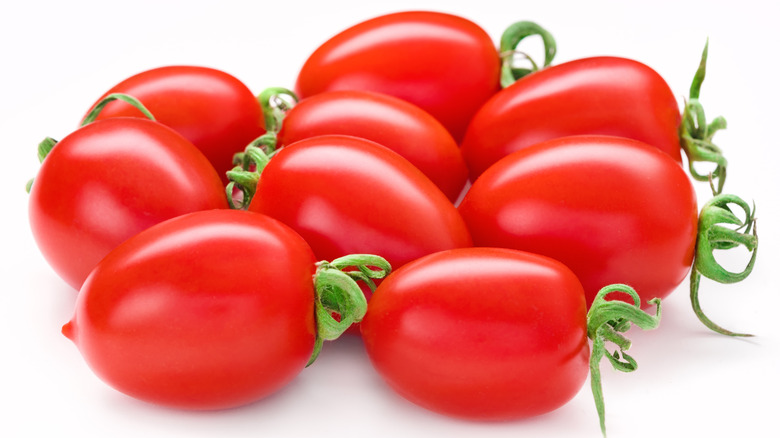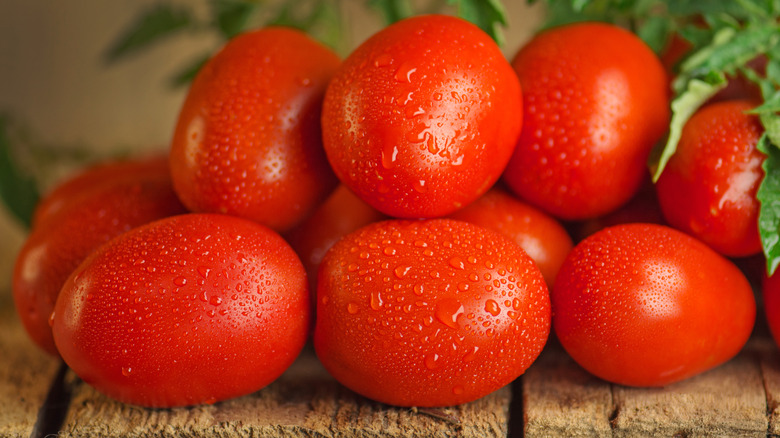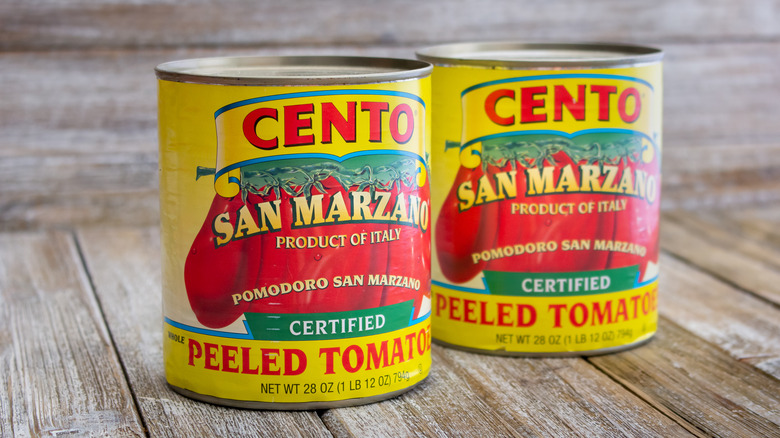San Marzano Vs. Roma Tomatoes: What's The Difference?
There is a wide variety of canned tomatoes available to us at the grocery store. Some are diced, others pureed, while whole peeled tomatoes remain a favorite among chefs and home cooks. Both San Marzano and Roma tomatoes are among the most common types used for canning. So what is the difference between these two tomatoes? Well, the first thing to recognize is their similar composition: Both have a higher flesh-to-juice ratio, which means that it contains a significantly smaller amount of that gelatinous and watery seed at the center. Thus, both are considered plum tomatoes, a type of tomato used to make sauces, per On the Gas.
So, when you're trying to make a pasta sauce from scratch, you'll probably have to decide between San Marzano and Roma tomatoes. But what is the difference between the two varieties of plum tomato, and which one is better for which purpose?
Roma tomatoes
Roma tomatoes, like San Marzano tomatoes, are frequently grown for canning or for tomato puree. Specialty Produce describes Roma tomatoes as being meatier than they are juicy, which is why they fall under the plum tomato category. Roma tomatoes have a characteristically elongated shape, with high sugar and acid levels which make them more flavorful than slicing tomatoes (via Specialty Produce). This particular type of tomato is great for salsa, bruschetta, tomato soup, and sauces due to its lower moisture content.
According to Harvesting History, Roma tomatoes are actually a recent invention of the USDA, first introduced to the public in 1955. Believed to be a genetically modified hybrid of the famous San Marzano and Pan American tomato, Roma tomatoes were made to be highly disease resistant, flavorful, and durable in colder temperatures, per Specialty Produce. Since their debut in the American market, they've continually gotten longer in shape, perhaps due to genetic modification to make the flesh sturdier. Roma tomatoes grow abundantly in cooler and warm temperatures, making them an incredibly affordable crop in the States.
San Marzano tomatoes
Some swear that these tomatoes are the only ones that should be used for pasta sauce. Certainly, San Marzano tomatoes have a status in their name, even bearing the D.O.P. mark that certifies their place of origin in the fertile volcanic soils of the Agro Sarnese-Nocerino region of Italy, per The Spruce Eats. After all, Roma tomatoes were made in lieu of these iconic tomatoes, which were first propagated in Italy in 1926, per Harvesting History. Furthermore, Yummy Mummy Kitchen states that what makes these tomatoes unique is that there are certain standards for picking them at optimal ripeness and canning them in a very particular manner, without salt or preservatives.
While both Roma and San Marzano tomatoes are low-moisture plum tomatoes, San Marzano tomatoes only have two seed chambers and tend to be longer and pointier than Roma tomatoes (via Specialty Produce). They have a mild acidity, as opposed to Roma's high acidic profile, making them sweeter and jammier. San Marzano tomatoes are the preferred tomatoes for most tomato sauces, particularly for authentic Neapolitan pizzas. This special tomato's D.O.P. status also makes it so it can only be canned whole or filleted, not diced (some fake San Marzano tomatoes come diced). To sum it up: San Marzano tomatoes are fancy, artisanal tomatoes, while Roma are an affordable alternative.


